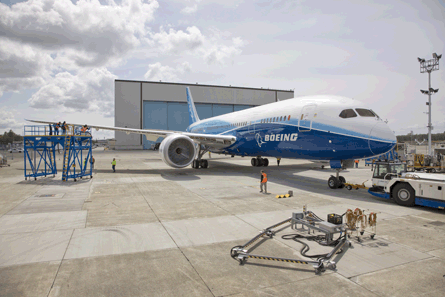While Boeing 787’s recent rapid progress is a welcome change after nearly two years of delays, lingering in the background are concerns over the airframer abililty to meet customer promises as the airframer acknowledges its early 787s will be heavy.
The confirmation comes in the wake of a report by a Wall Street research firm which raises concerns over the airframer’s ability to meet performance as well as describing production goals - even after being revised – as remaining highly ambitious
Bernstein Research estimates that early production 787s could be delivered as much as 8% overweight resulting in a range shortfall of 10-15%, putting the 787’s range at 12,800km (6,900nm), well below the advertised ranges of 14,200-15,200km.
Boeing confirms that “early airplanes are heavy and [we] are working hard on implementing weight improvements”.
Despite this, the airframer insists that it will “meet mission payload commitments to all customers”. Adding that the Bernstein report’s “conclusion on range is inaccurate and the 787-8’s range is closer to 8,000nm [14,800km] than 7,000nm”.
Boeing already plans to incorporate an initial round of weight savings into its seventh airframe, which is the first production 787, followed by blockpoint changes in aircraft 20 and 100. These will incorporate improvements from the lessons learnt in the flight-test programme, as well as take advantage of design improvements developed for the larger 787-9 variant.
 |
|---|
| © Boeing |
Bernstein also doubts the ability of the production system to meet its goal of producing 10 aircraft a month by the end of 2012, suggesting that at least an additional six months will be needed to reach the ambitious production rate by mid-2013.
“The Tier 1 suppliers have not yet validated their production capacities with the new production technology, and if substantial redesign is needed to reduce weight, it will further complicate a rapid increase in delivery rates,” the report notes.
In response, Boeing maintained its production forecasts and that it is “fully coordinating with partners on production readiness and the critical design block points changes” to meet the planned ramp-up.
The Bernstein report also describes the manufacturer’s plan to complete the 787 flight-test programme, certificate and deliver the first aircraft to Japan’s All Nippon Airways in the first quarter of 2010 as “ambitious”.
The airframer has reaffirmed its 787 flight test methodology saying the plan is “based upon our experience with the 777 programme”. 787 flight-testing will be a 24/7 programme that will aim to better use available ground time, while in addition providing a 20% margin to conduct certification trials of the new twinjet in time for the February 2010 delivery target.
Source: FlightGlobal.com























